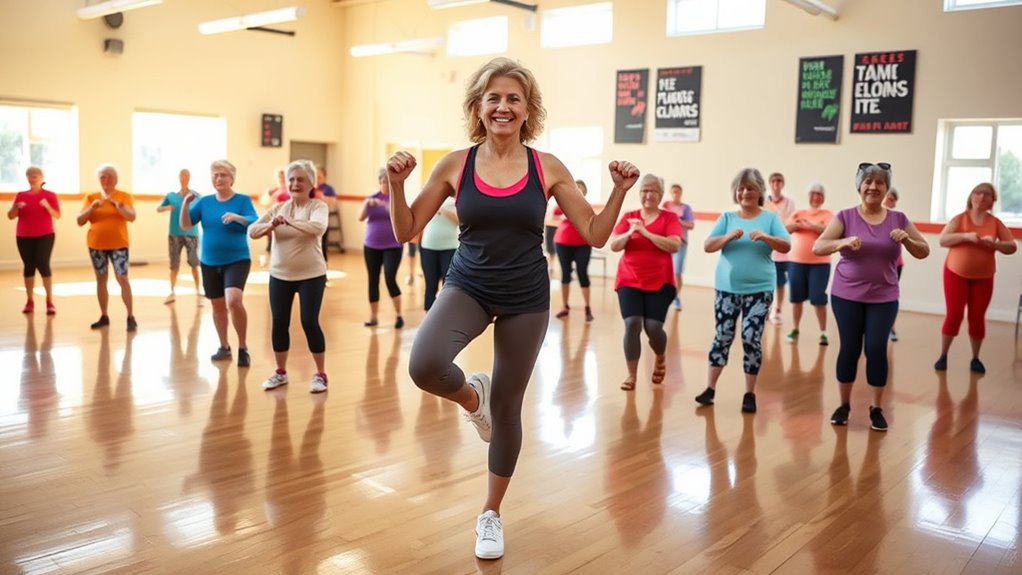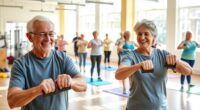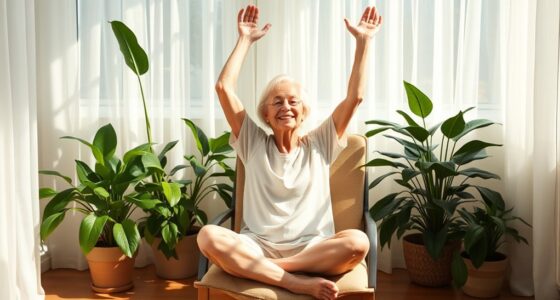Senior exercise classes can transform your health by boosting your physical fitness and mental well-being. Engaging in programs like EnhanceFitness or Tai Chi improves strength, balance, and flexibility, all essential for maintaining independence. You’ll not only enhance your mobility but also reduce the risk of falls and chronic ailments. Plus, these classes foster social connections, combating loneliness. Interested in discovering what specific programs can best support your journey toward better health?
Key Takeaways
- EnhanceFitness offers community-focused classes that improve physical abilities by 35% and can save participants approximately $945 in healthcare costs annually.
- Tai Chi for Arthritis enhances movement, balance, and flexibility, significantly reducing pain while promoting overall mobility for older adults.
- Fit and Strong! emphasizes flexibility, strength, and aerobic walking, specifically designed for seniors with osteoarthritis to enhance physical functioning.
- Aquatic aerobics provides a low-impact exercise option that improves mobility and fosters community support, ideal for older adults with joint pain.
- Group exercise classes, like those in Enhance®Fitness, reduce feelings of loneliness and enhance mental well-being, leading to fewer depressive symptoms.
The Importance of Exercise for Older Adults

Exercise is crucial for older adults, as it helps maintain health and independence. Regular physical activity, like participating in fitness programs, can greatly enhance your quality of life.
Experts recommend at least 150 minutes of moderate aerobic activity each week to reap the health benefits associated with an active lifestyle. However, less than one-third of older adults currently meet these guidelines.
Engaging in both aerobic and muscle-strengthening exercises not only helps prevent chronic diseases but also combats functional decline. Financial considerations for assisted living can highlight the importance of staying active to avoid potential healthcare costs. Consistent exercise boosts mental well-being, reducing symptoms of depression and anxiety, and it can also improve emotional well-being for individuals facing health challenges. Additionally, understanding developmental milestones can help older adults set realistic fitness goals that align with their capabilities. Incorporating regular physical activity into daily routines is essential for enhancing overall health and longevity. Furthermore, establishing a structured routine can help promote stability and consistency in physical activity.
Connecting with community organizations through the National Council on Aging can provide essential support and resources to help you stay active and enjoy a healthier, more fulfilling life.
Recommended Physical Activity Guidelines

To stay healthy, you should aim for at least 150 minutes of moderate aerobic activity each week. Incorporating muscle-strengthening exercises on two or more days is essential for maintaining strength and bone health. Additionally, engaging in activities that promote digital literacy programs can help seniors stay connected and reduce feelings of isolation. Regular physical activity not only supports physical well-being but also enhances mental health by reducing stress and improving mood. Furthermore, staying physically active can be crucial for managing RMDs effectively in retirement, ensuring that you maintain a healthy lifestyle while navigating financial obligations. Engaging in regular exercise can also foster emotional well-being, which is vital for overall health, as it can help combat the effects of running dry that many seniors may experience.
Weekly Activity Goals
When it comes to maintaining a healthy lifestyle, older adults should aim for at least 150 minutes of moderate aerobic activity each week.
Setting weekly activity goals can help older adults improve their health and enhance their overall well-being. Here are some tips to achieve those goals:
- Incorporate Muscle-Strengthening Activities: Aim for these on two or more days each week to boost physical function and build personal resilience in the face of health challenges. Engaging in physical activities can also aid in managing the effects of stress from life changes. Additionally, developing strong communication skills through group classes can enhance social connections, further supporting mental health. Heat pumps can significantly lower carbon emissions, contributing to a sustainable environment for future generations.
- Break It Down: Divide your exercise into shorter sessions of 10 to 15 minutes throughout the day, making it easier to stay active.
- Join Structured Programs: Engage in classes like Enhance®Fitness, where participants report significant improvements in physical functioning.
Additionally, regular physical activity can serve as an effective coping strategy for adults during challenging times, such as those brought on by life changes like divorce.
Types of Activities
Engaging in a variety of activities is essential for older adults to meet the recommended physical activity guidelines. Aim for at least 150 minutes of moderate aerobic activity each week, like walking, swimming, or cycling. Joining a fitness class can make this more enjoyable and social. Additionally, creating an environment that promotes senior living experience can further motivate participation in these activities. Research shows that regular physical activity can significantly improve health outcomes in older adults, leading to enhanced quality of life. Furthermore, incorporating STEM education into community programs can stimulate cognitive engagement and social interaction among seniors.
Incorporating regular exercise can also benefit mental stimulation, which is vital for maintaining cognitive function. Additionally, incorporate strength training two or more days a week to enhance overall strength and functional ability. Shorter sessions, like 10 or 15 minutes throughout the day, can help you reach these goals. Don’t forget to include flexibility and balance exercises as well, which are vital for fall prevention. By diversifying your routine, you’ll improve mobility, maintain independence, and reduce the risk of chronic conditions. Implementing data-driven decision-making can also help tailor your fitness program to better suit your individual needs.
Importance of Strength Training
Incorporating strength training into your weekly routine is essential for maintaining overall health and functional ability as you age.
The CDC recommends that older adults engage in muscle-strengthening activities at least two days a week.
Here are three key benefits of strength training:
- Prevent Falls: Regular strength training improves balance and coordination, greatly reducing the risk of falls, a leading cause of injury among older adults.
- Boost Health: It helps combat muscle and bone mass loss, which is vital for preventing conditions like osteoporosis.
- Enhance Mental Well-being: Strength training contributes to better mental health, with many participants reporting reduced rates of depression. Additionally, muscle-strengthening activities are crucial for improving overall physical health and functional capacity in older adults.
Evidence-Based Exercise Programs

When you explore evidence-based exercise programs, you’ll find diverse options tailored to your needs.
These programs not only enhance your physical functioning but also offer proven health benefits, like reduced rates of depression.
Diverse Program Options
As you explore diverse program options for senior exercise, you’ll find evidence-based exercise programs tailored to meet the unique needs of older adults.
These programs not only aim to improve physical health, but they also enhance overall well-being and safety.
Here are three effective choices:
- EnhanceFitness: A community-focused class that helps older adults, especially those with arthritis, improve their physical functioning.
- Tai Chi for Arthritis for Falls Prevention: This program combines gentle movements, focusing on balance and flexibility, while fostering social connections.
- Fit and Strong!: Designed for seniors with osteoarthritis, this exercise program emphasizes flexibility, strength, and aerobic walking to promote holistic health improvements.
Choosing any of these options can greatly benefit your health journey!
Proven Health Benefits
Engaging in evidence-based exercise programs can greatly enhance your health and well-being as you age. These proven programs offer numerous benefits for older adults, from improved physical functioning to mental health enhancements. For instance, participants in EnhanceFitness report a 35% improvement in physical abilities and save an average of $945 in healthcare costs annually. Programs like Moving For Better Balance help prevent falls, while Walk with Ease reduces pain and depression.
| Program | Benefits | Target Group |
|---|---|---|
| EnhanceFitness | 35% improvement in physical functioning | Older adults |
| Moving For Better Balance | Fall prevention | Older adults |
| Walk with Ease | Decreases pain and depression | Older adults |
Specialized Programs for Fall Prevention and Balance

Specialized programs for fall prevention and balance, such as Tai Chi for Arthritis and Walk with Ease, can greatly enhance your stability and mobility. Engaging in these classes offers you a chance to improve your overall strength and coordination, considerably lowering your fall risk.
Specialized fall prevention programs like Tai Chi for Arthritis can significantly boost your strength and reduce your risk of falling.
Here are three effective programs to evaluate:
- Tai Chi for Arthritis: This program enhances movement, balance, and flexibility while reducing pain.
- Tai Ji Quan: Moving for Better Balance®: Focuses on a simplified routine tailored for older adults, improving mobility and stability.
- Walk with Ease: Provides personalized walking plans that increase physical activity and help manage pain.
The Benefits of Restorative or Modified Yoga

Restorative or modified yoga offers numerous benefits that can greatly enhance your physical and mental well-being. This practice improves flexibility, strength, and stability, which is essential for maintaining your independence as you age.
Engaging in restorative yoga regularly can boost your balance, making daily tasks much easier. For those with mobility challenges, chair yoga provides accessible alternatives, allowing you to participate comfortably.
As you relax and focus on mindfulness through these practices, you’ll also notice improvements in your mental health and emotional well-being.
Exploring Aquatic Aerobics for Joint Health
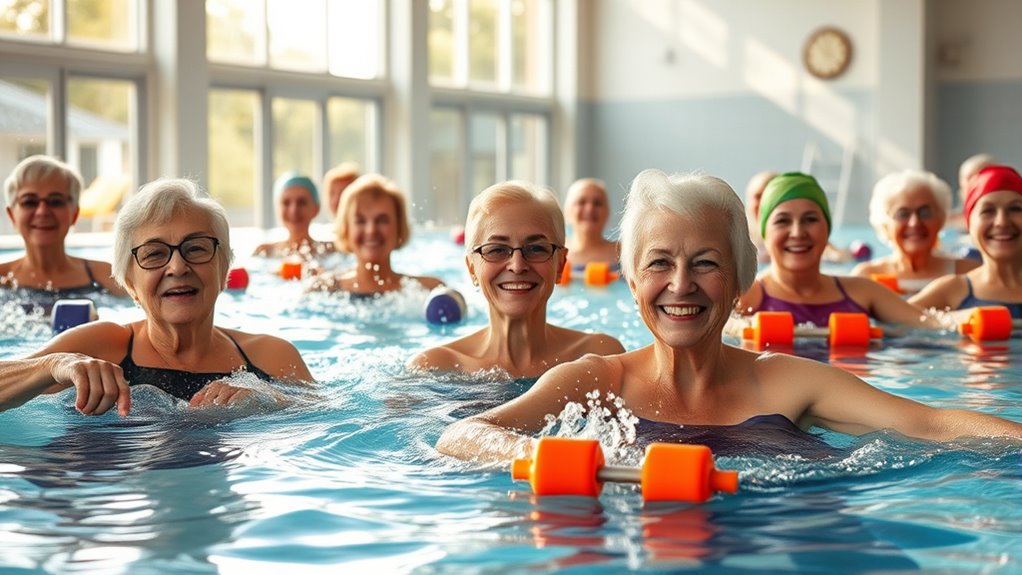
Have you ever considered how aquatic aerobics can transform your joint health? This low-impact exercise is perfect for older adults, especially those dealing with arthritis or joint pain.
Aquatic aerobics is a transformative, low-impact exercise ideal for older adults facing joint pain or arthritis.
Here are three key benefits:
- Reduced Impact: Water’s buoyancy greatly lessens stress on bones and joints, allowing you to exercise without pain.
- Enhanced Mobility: The warm water promotes muscle relaxation and can improve your range of motion, making movements easier.
- Social Support: Participating in aquatic aerobics fosters a sense of community, encouraging regular attendance and motivation.
Studies show that those who engage in aquatic aerobics often report better joint health and reduced pain.
Functional Fitness: Enhancing Daily Activities

When it comes to staying active as you age, functional fitness plays an essential role in enhancing your daily activities. This type of exercise focuses on movements that mimic everyday tasks, helping you strengthen muscles and improve coordination.
For older adults, engaging in functional fitness can greatly reduce the risk of falls by enhancing balance and stability. Classes typically incorporate strength training, flexibility, and balance exercises, aligning with recommendations for maintaining physical functionality.
As you participate, you may notice increased confidence in your physical abilities, allowing you to perform tasks independently, like sitting down or reaching for items on high shelves.
Ultimately, functional fitness promotes autonomy and leads to a more active lifestyle and better overall health outcomes.
The Connection Between Mental Health and Exercise
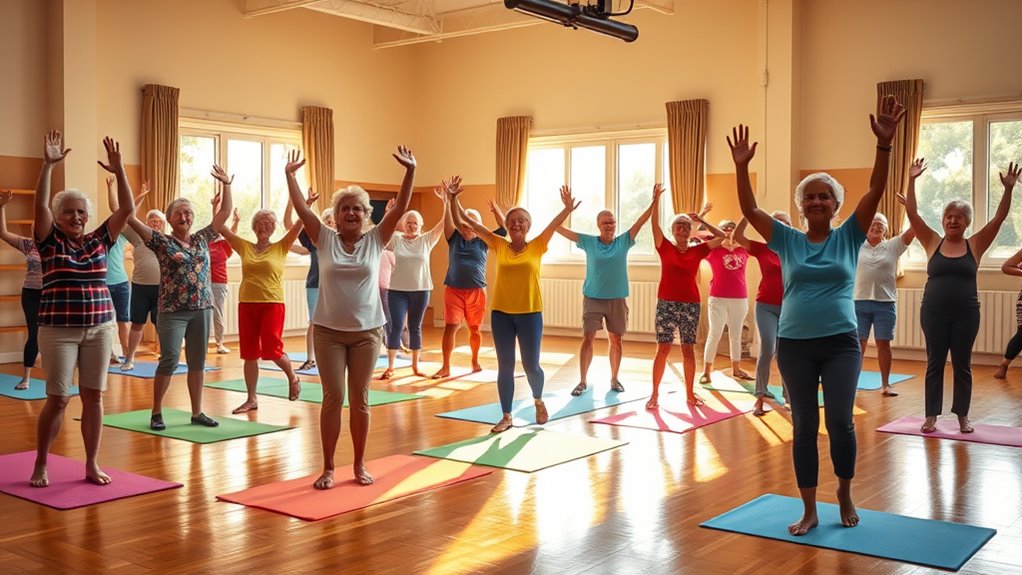
Engaging in regular exercise not only strengthens your body but also considerably boosts your mental health. For older adults, joining group classes can enhance well-being in several ways:
- Mood Improvement: Exercise releases brain chemicals that help combat sadness and anxiety, uplifting your overall mood.
- Cognitive Function: Physical activity improves memory and problem-solving skills, keeping your mind sharp as you age.
- Social Interaction: Group fitness classes foster a sense of community, reducing feelings of loneliness and enhancing your sense of belonging.
With studies showing that 53% of Enhance®Fitness participants experienced fewer depressive symptoms, it’s clear that staying active is crucial for both your physical and mental health.
Embrace exercise as an essential part of your life!
Getting Started: Tips for Seniors to Stay Active
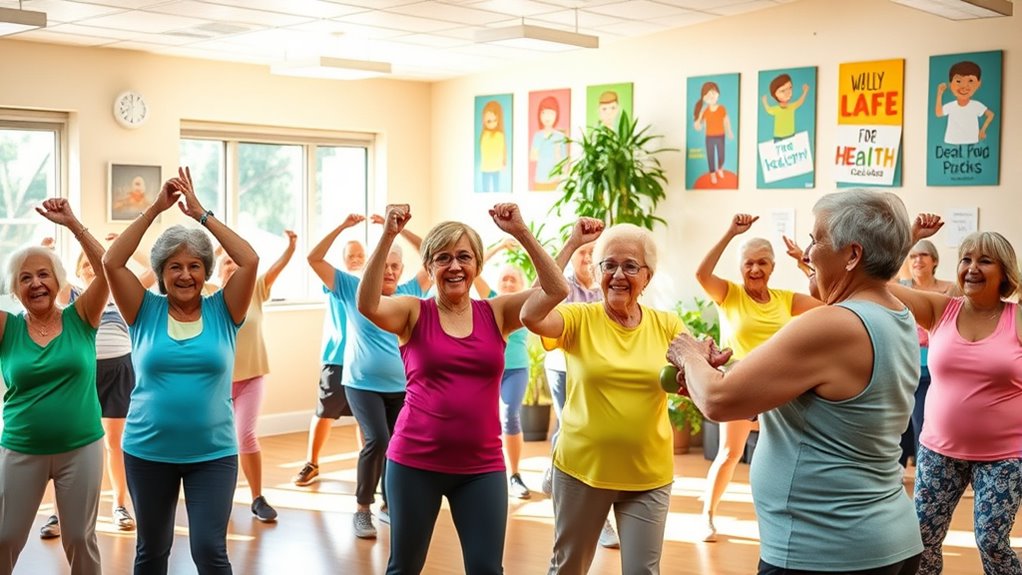
As you begin your fitness journey, starting small can make all the difference in staying active. Consult with your doctor before diving into any new exercise programs to guarantee safety and tailor activities to your health needs.
Aim for at least 150 minutes of moderate aerobic activity each week, breaking it down into manageable 10-15 minute sessions. Choose fun classes like EnhanceFitness or chair yoga that match your fitness level to keep motivation high.
Wear comfortable clothing and supportive shoes to enhance your experience and reduce injury risks. Attend classes regularly, even if infrequently, to build a routine.
Staying active not only improves physical health but also boosts mental well-being, so find the right Health Programs that work for you as an older adult.
Frequently Asked Questions
What Is the Number One Exercise Seniors Should Do?
As the saying goes, “A journey of a thousand miles begins with a single step.”
For seniors, that step is walking. It’s the number one exercise you should do since it’s low-impact and easily adjustable to your fitness level. Aim for at least 150 minutes a week, and you’ll enhance your strength, balance, and overall well-being.
Plus, walking can boost your mood and connect you with others, making it an essential part of your routine.
What Is the Best Exercise Class for Seniors?
The best exercise class for seniors really depends on your personal needs and preferences.
If you’re looking to improve balance and flexibility, Tai Chi for Arthritis can be fantastic.
For strength, Geri-Fit offers specialized resistance training.
Aquatic aerobics is perfect if you have joint issues and want a low-impact option.
If you prefer walking, classes like Walk with Ease can help you stay active while reducing pain.
Choose what feels right for you!
What Is the Number One Exercise to Increase Balance in Seniors?
The number one exercise to increase balance in seniors is Tai Chi.
You’ll find that its slow, controlled movements enhance your stability and coordination, making it perfect for various fitness levels.
By practicing Tai Chi regularly, you can greatly reduce your risk of falls—up to 47%, in fact.
Plus, classes like Tai Chi for Arthritis offer a structured environment where you can safely learn and improve your balance, boosting your confidence and independence.
What Is the AARP #1 Exercise for Seniors?
Imagine a gentle stream, flowing effortlessly through a vibrant forest.
Just like that stream, walking is the AARP’s #1 exercise for seniors. It’s an easy, low-impact way to enhance your health and maintain independence.
By incorporating 30 minutes of walking into your daily routine, you’ll not only improve your cardiovascular health and strength but also uplift your mood.
Conclusion
So, why not plunge into these senior exercise classes? After all, who needs a daily dose of energy and health when you can just sit back and watch reruns all day? Sure, falling into a chair might seem comfortable, but wouldn’t it be more fun to actually get up and move? Embrace the irony: staying active could actually help you enjoy your golden years instead of just surviving them. Let’s lift those weights—your future self will thank you!
